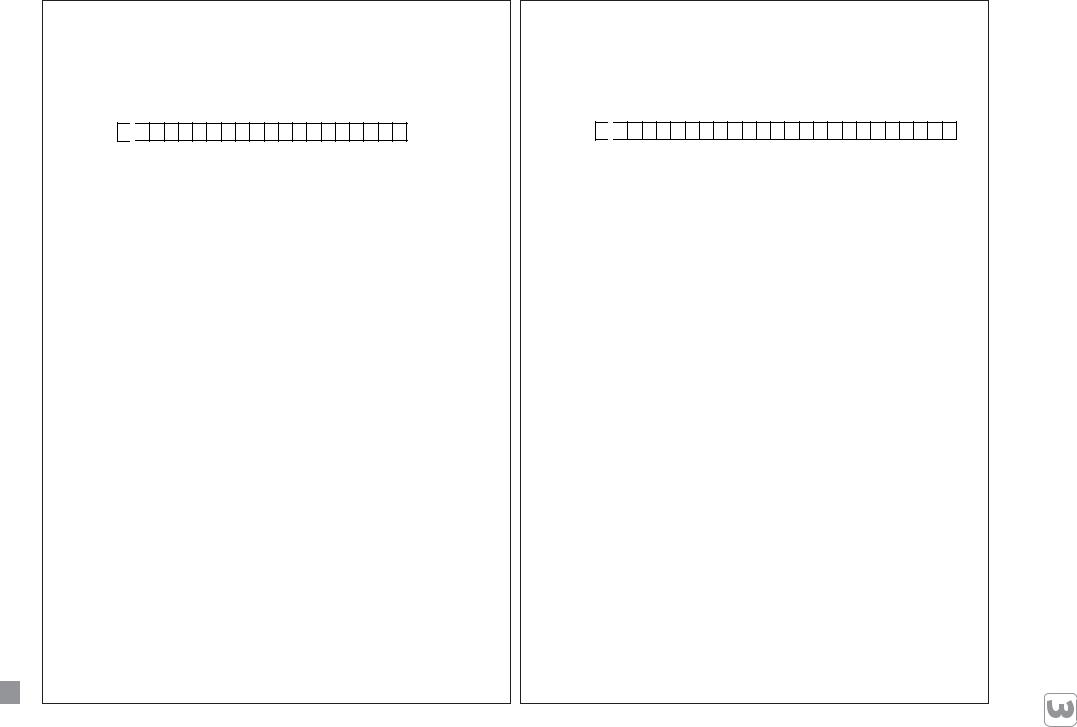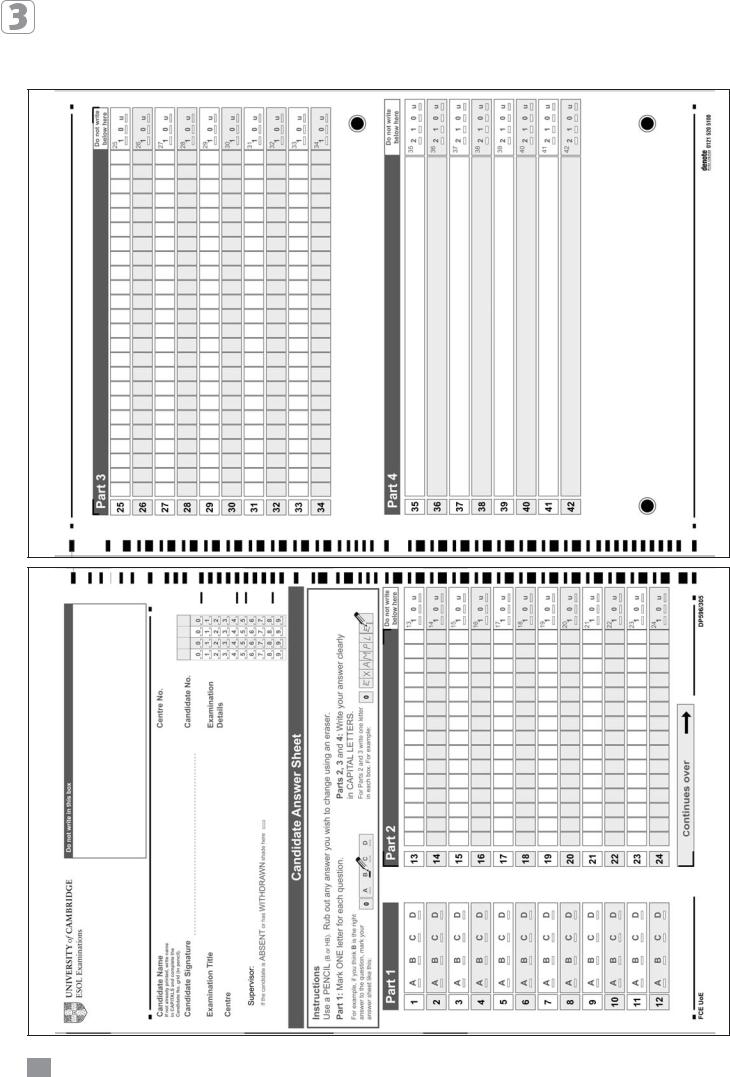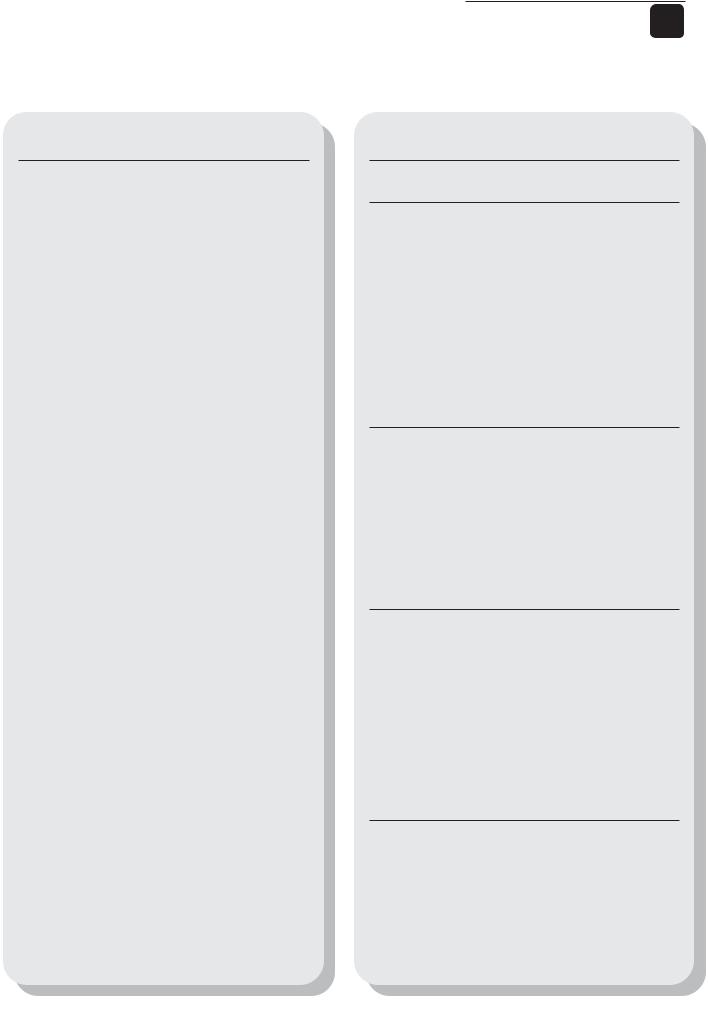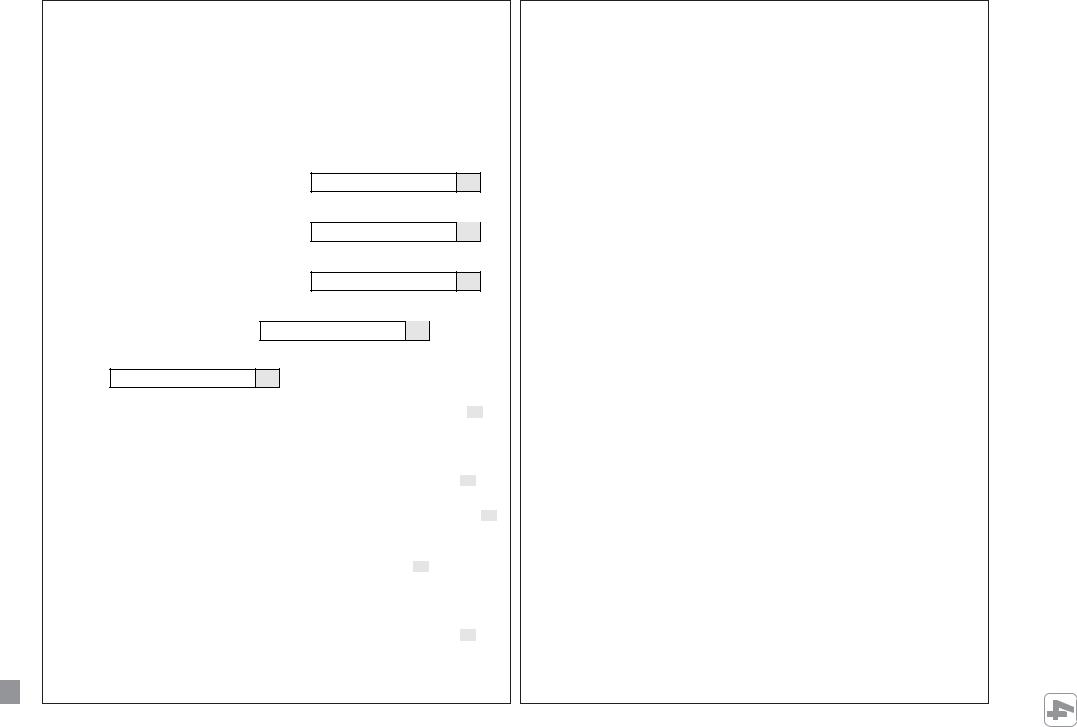
fce_handbook
.pdf
49 2 st te – r pe pa e l p m sa | ish l g n e f o use : 3 r pe pa | s r e h c a e t r o f k o o b d n a h e c f
Part 2
For questions 13 – 24, read the text below and think of the word which best fits each gap. Use only one word in each gap. There is an example at the beginning (0).
Write your answers IN CAPITAL LETTERS on the separate answer sheet.
Example: 0 
 O N E
O N E
_________________________________________________________________________________
Fashion
Throughout history people have worn clothing of (0) …….... description or another. Apart (13) …….... protection against the weather, clothes were also often used to show the wearer’s status and wealth. Over the years, numerous fashions in clothing have come and gone. (14) …….... some of these have been popular for relatively short periods, others have lasted longer.
Until the first half of the 20th century, the ability to follow fashion was limited to those (15) …….... had the money to (16) …….... so. But following fashion did not only demand money, it also required large amounts of leisure time. Wealthy people took fashion very seriously and close attention had to
(17) …….... paid to detail. Wearing the correct clothes for different occasions was very important, despite the (18) …….... that this often meant changing clothes five or six (19) …….... a day.
More recently, fashionable clothes have come within the reach of ordinary people. The traditional craft of dressmaking, (20) …….... usually involved sewing (21) …….... hand, was both costly and slow. But today, large-scale manufacturing has made it easier for people to keep (22) …….... with changes in fashion (23) …….... having to spend a great (24) …….... of money.
4
Part 3
For questions 25 – 34, read the text below. Use the word given in capitals at the end of some of the lines to form a word that fits in the gap in the same line. There is an example at the beginning (0).
Write your answers IN CAPITAL LETTERS on the separate answer sheet.
Example: 0 
 A F R I C A N
A F R I C A N
_________________________________________________________________________________
Tourism in Tanzania
Over the past few years, tourism in the East (0) ………..country of |
AFRICA |
Tanzania has been growing fast. Tanzania has a really (25) ………. |
FASCINATE |
multi-cultural history and is home to many different tribes. They live |
|
peacefully together and have a wide range of (26) ………. , such as |
OCCUPY |
farming and making traditional (27) ………. . Visits to tribal villages, |
JEWEL |
notably to those of the Masaai in the north of the country, are often a |
|
highlight of travel itineraries. Last year, Tanzania welcomed about |
|
290,000 visitors, which made tourism the (28) ………. most important |
THREE |
source of foreign exchanges; only coffee and cotton brought in more |
|
revenue. |
|
Tourists are attracted to Tanzania because of its (29) ………. beaches |
GOLD |
and its unusual (30) ………. features. It has lakes of amazing |
GEOGRAPHY |
(31) ………., and in Mount Kilimanjaro boasts the highest mountain on |
DEEP |
the African continent. Tanzania also has more land devoted to natural |
|
parks and game reserves than any other wildlife destination in the |
|
world. Everything, including the coral reefs, is protected by |
|
government law. |
|
Tanzania is (32) ………. placed to increase its tourist trade by offering |
IDEAL |
a (33) ………. of activity holidays. At the same time, it aims to avoid |
VARY |
the ‘mass tourism’ that has been a rather (34) ………. development in |
FORTUNATE |
other areas of similar beauty. |
|
Turn overŹ
24)–13 (questions 2 Part 2 Test |
|
34)–25 (questions 3 Part 2 Test and |
ENGLISH OF USE 3: PAPER |

2 st te – r pe pa e l p m sa | ish l g n e f o use : 3 r pe pa | s r e h c a e t r o f k o o b d n a h e c f 50
Part 4
For questions 35 – 42, complete the second sentence so that it has a similar meaning to the first sentence, using the word given. Do not change the word given. You must use between two and five words, including the word given. Here is an example (0).
Example:
0A very friendly taxi driver drove us into town.
DRIVEN
We ……………………………………………… a very friendly taxi driver.
The gap can be filled by the words ‘were driven into town by’, so you write:
Example: 0 WERE DRIVEN INTO TOWN BY
Write only the missing words IN CAPITAL LETTERS on the separate answer sheet.
_________________________________________________________________________________
35I think Robert is too young to look after his brother.
CARE
I think Robert isn’t ……………………………………………… of his brother.
36Tomas put up a fence so that people didn’t walk on his garden.
PREVENT
Tomas put up a fence ……………………………………………… on his garden.
37The twins are eager to see their cousins again in the summer.
LOOKING
The twins ……………………………………………… their cousins again in the summer.
38The last time Enrico saw Gloria was the day they left school.
SEEN
Enrico has ……………………………………………… the day they left school.
39Luckily, we had enough glasses at the party.
RUN
Luckily, we ……………………………………………… glasses at the party.
40Nicholas finally managed to get his new video recorder to work.
SUCCEEDED
Nicholas finally ……………………………………………… his new video recorder to work.
41You did not take enough care over your homework last week.
OUGHT
You ……………………………………………… more care over your homework last week.
42Reuben is the only person to have won the championship three times running.
NOBODY
Apart ……………………………………………… ever won the championship three times running.
ENGLISH OF USE 3: PAPER
42)–35 (questions 4 Part 2 Test

PAPER 3: USE OF ENGLISH
Answer keys
Test 2
PART ONE |
|
PART TWO |
PART THREE |
PART FOUR |
||||||
|
|
|
|
|
|
|
|
|
|
|
1 |
C |
13 |
from |
25 |
fascinating |
35 |
old enough ][ to take care |
|||
2 |
A |
14 |
Although/While/ |
26 |
occupations |
36 |
to prevent people ][ (from) |
|||
3 |
A |
|
|
Whereas/Whilst/Though |
27 |
jewellery/jewelry |
|
|
walking |
|
|
|
|
|
|
|
|||||
4 |
B |
15 |
who/that |
28 |
third |
37 |
are looking forward to ][ seeing |
|||
|
|
|
|
|
|
|||||
5 |
A |
16 |
do |
29 |
golden |
38 |
n’t/not seen Gloria ][ since |
|||
|
|
|
|
|
|
|||||
6 |
C |
17 |
be |
30 |
geographic(al) |
39 |
didn’t/did not run ][ out/short of |
|||
|
|
|
|
|
|
|||||
7 |
A |
18 |
fact |
31 |
depth(s) |
40 |
succeeded in ][ getting |
|||
|
|
|
|
|
|
|||||
8 |
C |
19 |
times |
32 |
ideally |
41 |
ought to ][ have taken |
|||
|
|
|
|
|
|
|||||
9 |
B |
20 |
which |
33 |
variety |
42 |
from Reuben ][ nobody (else) has |
|||
|
|
|
|
|
|
|||||
10 |
D |
21 |
by |
34 |
unfortunate |
][ shows where the answer is split for |
||||
|
|
|
marking purposes. |
|||||||
|
|
22 |
up |
|
|
|
||||
11 |
D |
|
|
|
|
|
|
|||
|
|
|
|
|
|
|
|
|
||
12 |
D |
23 |
without |
|
|
|
|
|
|
|
|
|
|
|
|
|
|
|
|
||
|
|
24 |
deal/amount/sum |
|
|
|
|
|
|
|
f c e h a n d b o o k f o r t e a c h e r s | pa pe r 3 : use o f e n g l ish | a ns we r k e ys f o r te st 2 |
51 |
|
|

PAPER 3: USE OF ENGLISH
Candidate answer sheet
52 f c e h a n d b o o k f o r t e a c h e r s | pa pe r 3 : use o f e n g l ish | c a n d i date a ns we r sh e e t

GENERAL DESCRIPTION
Paper format |
The paper contains four parts. Each |
|
part contains a recorded text or texts |
|
and corresponding comprehension |
|
tasks. Each part is heard twice. |
|
|
Timing |
Approximately 40 minutes. |
|
|
No. of parts |
4. |
|
|
No. of questions |
30. |
|
|
Task types |
Multiple choice, sentence |
|
completion, multiple matching. |
|
|
Text types |
Monologues: answerphone messages, |
|
information lines, commentaries, |
|
radio documentaries and features, |
|
instructions, lectures, news, public |
|
announcements, publicity and |
|
advertisements, reports, speeches, |
|
stories and anecdotes, talks. |
|
Interacting speakers: conversations, |
|
discussions, interviews, quizzes, radio |
|
plays, transactions. |
|
|
Answer format |
Candidates are advised to write their |
|
answers in the spaces provided on |
|
the question paper while listening. |
|
There will be 5 minutes at the end of |
|
the test to copy the answers onto a |
|
separate answer sheet. |
|
Candidates indicate their answers by |
|
shading the correct lozenges or |
|
writing the required word or words |
|
in capital letters in a box on the |
|
answer sheet. |
|
|
Recording |
The instructions for each task are |
information |
given in the question paper, and are |
|
also heard on the recording. These |
|
instructions include the |
|
announcement of pauses of specified |
|
lengths, during which candidates can |
|
familiarise themselves with the task |
|
and, for some items, predict some of |
|
the things they are likely to hear. |
|
A variety of voices, styles of delivery |
|
and accents will be heard in each |
|
Listening paper to reflect the various |
|
contexts presented in the recordings, |
|
as appropriate to the international |
|
contexts of the test takers. |
|
|
Marks |
Each correct answer receives 1 mark. |
|
|
PAPER 4
LISTENING
STRUCTURE AND TASKS
PART 1
Task type |
Multiple choice. |
and focus |
General gist, detail, function, purpose, |
|
attitude, opinion, relationship, topic, place, |
|
situation, genre, agreement, etc. |
|
|
Format |
A series of short unrelated extracts, of |
|
approximately 30 seconds each, from |
|
monologues or exchanges between |
|
interacting speakers. There is one multiple- |
|
choice question per text, each with three |
|
options. |
|
|
No. of Qs |
8. |
|
|
PART 2
Task type |
Sentence completion. |
and focus |
Detail, specific information, stated opinion. |
|
|
Format |
A monologue or text involving interacting |
|
speakers and lasting approximately |
|
3 minutes. Candidates are required to |
|
complete the sentences with information |
|
heard on the recording. |
|
|
No. of Qs |
10. |
|
|
PART 3
Task type |
Multiple matching. |
and focus |
General gist, detail, function, purpose, |
|
attitude, opinion, relationship, topic, place, |
|
situation, genre, agreement, etc. |
|
|
Format |
Five short related monologues, of |
|
approximately 30 seconds each. The |
|
multiple-matching questions require |
|
selection of the correct option from a list |
|
of six. |
|
|
No. of Qs |
5. |
|
|
PART 4
Task type |
Multiple choice. |
and focus |
Opinion, attitude, gist, main idea, specific |
|
information. |
|
|
Format |
A monologue or text involving interacting |
|
speakers and lasting approximately |
|
3 minutes. There are seven multiple-choice |
|
questions, each with three options. |
|
|
No. of Qs |
7. |
|
|
f c e h a n d b o o k f o r t e a c h e r s | pa pe r 4 : l iste n |
53 |
|
|

The four parts of the
Listening paper
■ PART 1 – MULTIPLE CHOICE
This part tests candidates’ ability to listen for gist, detail, function, purpose, attitude, opinion, relationship, topic, place, situation, genre, agreement, etc. in a series of unrelated short texts.
Sample tasks, pages 56 and 65, tapescripts pages 59–61 and 68–70, and answer keys pages 64 and 73.
Each correct answer in Part 1 receives 1 mark.
The eight questions in this part of the paper are presented both on the question paper and on the recording, so that candidates are led carefully through them. The testing focus is spelled out in each question, for example:
•What is her job?
•Where is he going?
•Who are they talking about?
•What emotion/attitude/feeling/opinion is being expressed?
■PART 2 – SENTENCE COMPLETION
This part tests candidates’ ability to listen for specific words or phrases focusing on detail, specific information and stated opinion, from a single long text, and produce written answers by completing gapped sentences.
Sample tasks, pages 57 and 66, tapescripts pages 61–62 and 70, and answer keys pages 64 and 73.
Each correct answer in Part 2 receives 1 mark.
The 10 questions in this part of the paper take the form of incomplete sentences. The questions follow the order of the information in the listening text. Candidates need to listen to the text and complete the sentences.
Answers will not exceed three words in length. The word, number or phrase they require will be heard on the recording and will not require any change. It will make sense when fitted into the sentence on the question paper. Minor spelling errors are not penalised, but the candidate’s intention must be clear and unambiguous. Candidates will not be asked to spell words which are above FCE level. However, spelling must be correct where a word has been spelled out letter by letter, for example where the key is a proper name.
■ PART 3 – MULTIPLE MATCHING
In Part 3, the focus is on the skill of listening for general gist, detail, function, purpose, attitude, opinion, relationship, topic, place, situation, genre, agreement, etc. Candidates need to match an option to the correct speaker.
Sample tasks, pages 57 and 66, tapescripts pages 62 and 71, and answer keys pages 64 and 73.
Each correct answer in Part 3 receives 1 mark.
In this part, candidates listen to five short texts with different speakers, which are related in some way. For example, they may all be speaking about aspects of the same subject, such as travel, or about similar experiences or objects, such as journeys or vehicles. Alternatively, the link may be functional, such as a series of different speakers asking for information, or apologising.
■ PART 4 – MULTIPLE CHOICE
In Part 4, the predominant focus is on testing the candidates’ ability to listen for opinion and attitude, expressed in gist, main idea, and specific information, and based on one long text.
Sample tasks, pages 58 and 67, tapescripts pages 62–63 and 71–72, and answer keys pages 64 and 73.
Each correct answer in Part 4 receives 1 mark.
The seven questions in this part of the paper take the form of 3-option multiple-choice questions. The questions follow the order of the speakers’ comments as expressed during the course of the recording, and are presented in such a way that they either rephrase, report or summarise the ideas being expressed.
Preparation
General
■Students’ ability to understand what they hear can improve dramatically if they are regularly exposed to audio materials: the more English they hear, the more readily they will pick out individual words, then phrases and sentences. A daily learning programme which includes a ‘hearing English’ component from audio or video recordings will help prepare your students for the Listening test. This should include a range of voices, accents and styles of delivery.
■Classroom discussion activities provide an invaluable source of listening practice.
■Encourage your students to identify the stressed syllables and words in a listening text (the ones which carry the message) rather than trying to listen for every single syllable.
■In order to build up confidence, get your students to read a
54 |
f c e h a n d b o o k f o r t e a c h e r s | pa pe r 4 : l iste n i n g |
|
|

summary of what they are going to hear before they listen to the full text.
■Make your students aware of how much they themselves bring to a listening task. For example, discuss with them what they can expect to hear, e.g. names and places when they turn on the news, or numbers and times if they listen to railway announcements.
■Try changing the focus of the tasks they do in class; sometimes ask your students to listen for specifics, sometimes for overall summaries.
■Students should practise listening to and reading the question, so that they are sure they understand what they are listening for and what they have to do.
■Remind your students that they should use the time allowed before each recording to read through all the questions carefully, so they are prepared for what they hear.
■Students should be advised that the information on the question paper is there to help them follow as they listen.
■Remind your students that they should write their answers for Part 2 clearly when they copy them onto the answer sheet, using CAPITAL LETTERS.
■Students should get used to answering all the questions, even if they are not sure of the correct answer – they’ve probably understood more than they think.
■Students shouldn’t be distracted by individual words and phrases in Parts 1, 3 and 4. They should listen to the whole message.
■Students should know when to stop concentrating on a question which they are finding difficult, so that they don’t miss the next question.
By part
■PART 1
■Play real-life snippets to your students, e.g. a train announcement, a weather report, and ask them to identify the text type and topic.
■Candidates can be distracted by hearing words or phrases in the text which appear in one of the incorrect options. They need to practise spotting such mismatches, and understanding why they are wrong.
■Try using a variety of short practice texts. The questions should range from people to places, from opinions to events, from relationships to reasons. Provide the text and options, but get the students to write the questions themselves.
For example:
You overhear a man talking about a film he watched last night.
(Students suggest a question)
Options
A:a car
B:a family
C:a robbery
Text
Man: It’s so difficult to get everyone to agree about what we’re going to watch on TV. Is it the same in your house? Last night, for example, there were three films on. There was that one with the four sisters and their mother, during the American Civil War. Do you know the one I mean? I’d been looking forward to seeing it for ages. But the others had different ideas. Jessie was eager to see some cartoon thing about a car, but Lizzie wanted a thriller about two bank robbers. And rather than give in to each other, they both went with my choice – actually, we all enjoyed it.
■PART 2
■Preparation for this part should include lots of exposure to simple gap-fill listening exercises, and dictation of numbers and dates.
■Students need to get into the habit of reading not only the text in front of the gap, but also the text which follows the gap, which may affect their answer. You can reassure them that the tested items come in the same order as they are heard on the recording.
■Candidates sometimes write too much, either by including unnecessary detail, or by trying to rephrase what they hear on the recording. Irrelevant detail can spoil what would otherwise have been a correct answer. Candidates should be reminded that no changes are required to the key information, that no answer will need more than three words, and that in many cases they will need only one or two words.
■PART 3
■It is really important for candidates to use the time they are given to read through the questions, since they need to have a clear idea of what they are listening for. Students could practise doing the exercise with the tapescript, so that they can see the kind of matching required. Other relevant exercises would be any which practise ‘saying the same thing in a different way’.
■If your students are at all unsure about an answer, they should wait for the second listening before making their final decision. Making too quick a decision may mean that a candidate ‘uses up’ an answer that belongs to another speaker.
■PART 4
■In preparing for multiple-choice questions, it can be useful for students to answer questions in their own words before they look at the options; they can then decide which option seems to correspond most closely to their own answer.
f c e h a n d b o o k f o r t e a c h e r s | pa pe r 4 : l iste n i n g |
55 |
|
|

1 st te – r pe pa e l p m sa | g n i n iste l : 4 r pe pa | s r e h c a e t r o f k o o b d n a h e c f 56
Part 1
You will hear people talking in eight different situations. For questions 1 – 8, choose the best answer,
(A, B or C).
_________________________________________________________________________________
1You hear a young man talking. Why did he go back to college?
A He needed a better job.
B He needed an evening activity.
C He needed new skills.
2You hear a man talking on the radio. What is he?
A an inventor
B a company employee
C a writer
3You hear someone talking on the radio about an artist. How does the artist feel about his work?
A He would like to exhibit it in an art gallery.
B He wants to make his creations last longer.
C He is happy to see his work destroyed.
4You hear a woman talking to her son. Why is she talking to him?
A to give him a warning
B to refuse permission
C to make a suggestion
5You hear part of a lecture about the role of retired people in the economy. What is the lecturer describing?
A reasons why something is changing
B errors in statistical information
C disagreements between researchers
6You hear a chef being interviewed on the radio. Why did he decide to become a chef?
A to follow a family tradition
B to develop a natural talent
C to pursue his love of cooking
7You hear a teenager talking about the sport she plays. How does she feel while she is playing the sport?
Auncomfortable
Bembarrassed
Cconfident
8You hear an explorer talking about a journey he is making. How will he travel once he is across the river?
A by motor vehicle
B on horseback
C on foot
(questions 1 Part 1 Test |
LISTENING 4: PAPER |
8)–1 |
|
Turn over Ź

57 1 st te – r pe pa e l p m sa | g n i n iste l : 4 r pe pa | s r e h c a e t r o f k o o b d n a h e c f
Part 2
You will hear an interview with a woman called Helen Hunter who runs a summer camp for teenagers. For questions 9 – 18, complete the sentences.
_________________________________________________________________________________
SUMMER CAMPS
Helen says that people taking part in the summer camp usually sleep in a
9
The summer camp is a chance for teenagers to meet people and learn
10
As an example of a practical activity, Helen tells us about a team which built a
11
In the next camp, teams will work out problem-solving activities such as a
12 with clues.
Helen gives the example of
13 as the only typical sporting activity at the camp.
The day when teams can choose their own activities is called |
‘ |
|
|
’ |
14 |
|
|
||||
|
|
|
|
|
|
|
|
|
|
|
|
The summer camp is good for people who don’t have opportunities or have little |
|
|
|
|
|
|
|
||||
|
|
|
|
|
|
|
|
|
|
|
|
|
|
|
|
|
|
|
|
15 |
|
|
|
|
|
|
|
|
|
|
|
|
|
|
|
|
|
|
|
|
|
|
|||||
On ‘Battle of the Bands’ day, the teams make a pop record and a |
|
|
|
|
|
|
16 |
||||
|
|
|
|
|
|
|
|
|
|
||
For the teenagers taking part, the camp lasts for |
|
17 |
|
|
|
|
|
|
|||
|
|
|
|
|
|
|
|
|
|
|
|
You can book for a summer camp that will be held in the month of |
|
|
|
|
|
|
|
||||
|
|
|
|
|
|
|
|
|
|||
|
|
|
|
|
|
|
|
18 |
|
|
|
|
|
|
|
|
|
|
|
|
|
|
|
Part 3
You will hear five different people talking about a mistake they recently made. For questions 19 – 23, choose from the list (A – F) the type of mistake that each person made. Use the letters only once. There is one extra letter which you do not need to use.
_________________________________________________________________________________
Aignoring someone’s advice
|
Speaker 1 |
|
19 |
B |
failing to inform someone about something |
|
|
|
|
|
|
|
Speaker 2 |
|
20 |
C |
mistaking someone’s identity |
|
|
|
|
|
|
|
Speaker 3 |
|
21 |
D |
arriving somewhere too early |
|
|
|
|
|
|
|
Speaker 4 |
|
22 |
E getting a particular date wrong |
|
|
|
|
|
|
|
|
Speaker 5 |
|
23 |
F |
losing something important |
|
|
Turn over Ź
18)–9 (questions 2 Part 1 Test |
|
23)–19 (questions 3 Part 1 Test and |
LISTENING 4: PAPER |

1 st te – r pe pa e l p m sa | g n i n iste l : 4 r pe pa | s r e h c a e t r o f k o o b d n a h e c f 58
Part 4
You will hear an interview with a conservationist who has built a cable car in the rainforest. For questions 24 – 30, choose the best answer (A, B or C).
_________________________________________________________________________________
24What feature of the cable car makes it particularly good for seeing wildlife in the rainforest?
A the speed at which it moves
B the height at which it travels
C the distance that it covers
25What is the main aim of the cable car project?
A to educate local people
B to persuade people to save the rainforest
C to raise money for other conservation projects
26What is the advantage of the project for the local people?
A They can use the land if they want.
B They can sell forest products to the visitors.
C More work is available to them.
27Why was the cable car redesigned?
A so that people could touch the trees
B to avoid cutting down too much forest
C because it had to be brought in by air
28How does Donald react to the suggestion that he has disturbed the wildlife?
A He explains what happened in the past.
B He criticises what happens elsewhere.
C He denies that there’s been any disturbance.
29Why is Donald sure his project is a success?
A This piece of forest has survived.
B Animals have returned to the area.
C Other projects have copied his ideas.
30Donald thinks the future survival of the rainforest will depend on
A the size of the world’s population.
B the attitude of people towards it.
C the size of the areas left as forest.
(questions 4 Part 1 Test |
LISTENING 4: PAPER |
30)–24 |
|
